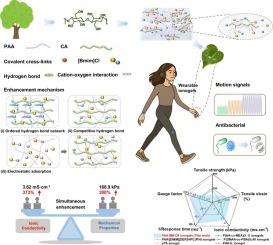醋酸纤维素用于多功能柔性传感器的可持续和抗菌离子凝胶的机械性能和离子电导率的同时增强
IF 13.2
1区 工程技术
Q1 ENGINEERING, CHEMICAL
引用次数: 0
摘要
柔性离子凝胶在机器人和人类健康方面受到越来越多的关注,但在平衡机械强度和离子电导率方面面临两难。本文提出了一种由醋酸纤维素(CA)、丙烯酸(AA)和离子液体(IL)组成的多键纠缠网络,用于制备具有良好力学性能、高离子电导率和优异传感性能的可持续抗菌离子凝胶。结果表明,优化后的离子凝胶的抗拉强度为168.9 kPa,断裂伸伸率为1250.7 %,压应力为0.53 MPa,离子电导率为3.62 mS·cm−1。离子凝胶还具有良好的粘附性(95 kPa),高应变敏感性(GF = 2.45),抗菌性能,透明度和环境稳定性。此外,离子凝胶对外部刺激的反应时间为190 ms,这使它们成为动态监测人体运动信号的理想选择。讨论了增强机理。它提供了一种创新的策略来开发具有优异综合性能的离子凝胶,用于柔性电子和可穿戴传感器的应用。本文章由计算机程序翻译,如有差异,请以英文原文为准。

Simultaneous enhancement of mechanical properties and ionic conductivity of sustainable and antibacterial Ionogels by cellulose acetate for versatile flexible sensors
Flexible ionogels have gained increasing attention for robots and human health, but faces a dilemma in balancing mechanical strength and ionic conductivity. Herein, a multi-bonded entangled network composed of cellulose acetate (CA), acrylic acid (AA) and ionic liquid (IL) has been presented to create sustainable and antibacterial ionogels with good mechanical properties, high ionic conductivity, and excellent sensing performance. The properties of the ionogels varies with the content and degree of substitution of CA, and the optimized ionogels exhibit a tensile strength of 168.9 kPa, a fracture elongation of 1250.7 %, a compressive stress of 0.53 MPa, and an ionic conductivity of 3.62 mS·cm−1, comparable to the reports. The ionogels also demonstrate good adhesion (95 kPa), high strain sensitivity (GF = 2.45), antibacterial properties, transparency, and environmental stability. In addition, the ionogels respond to external stimuli in 190 ms, leaving them an ideal option for dynamically monitoring human motion signals. The enhancement mechanisms are discussed. It provides an innovative strategy to develop ionogels with excellent overall performance for applications in flexible electronics and wearable sensors.
求助全文
通过发布文献求助,成功后即可免费获取论文全文。
去求助
来源期刊

Chemical Engineering Journal
工程技术-工程:化工
CiteScore
21.70
自引率
9.30%
发文量
6781
审稿时长
2.4 months
期刊介绍:
The Chemical Engineering Journal is an international research journal that invites contributions of original and novel fundamental research. It aims to provide an international platform for presenting original fundamental research, interpretative reviews, and discussions on new developments in chemical engineering. The journal welcomes papers that describe novel theory and its practical application, as well as those that demonstrate the transfer of techniques from other disciplines. It also welcomes reports on carefully conducted experimental work that is soundly interpreted. The main focus of the journal is on original and rigorous research results that have broad significance. The Catalysis section within the Chemical Engineering Journal focuses specifically on Experimental and Theoretical studies in the fields of heterogeneous catalysis, molecular catalysis, and biocatalysis. These studies have industrial impact on various sectors such as chemicals, energy, materials, foods, healthcare, and environmental protection.
 求助内容:
求助内容: 应助结果提醒方式:
应助结果提醒方式:


